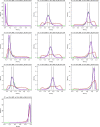Predicting DNA methylation level across human tissues
- PMID: 24445802
- PMCID: PMC3973306
- DOI: 10.1093/nar/gkt1380
Predicting DNA methylation level across human tissues
Abstract
Differences in methylation across tissues are critical to cell differentiation and are key to understanding the role of epigenetics in complex diseases. In this investigation, we found that locus-specific methylation differences between tissues are highly consistent across individuals. We developed a novel statistical model to predict locus-specific methylation in target tissue based on methylation in surrogate tissue. The method was evaluated in publicly available data and in two studies using the latest IlluminaBeadChips: a childhood asthma study with methylation measured in both peripheral blood leukocytes (PBL) and lymphoblastoid cell lines; and a study of postoperative atrial fibrillation with methylation in PBL, atrium and artery. We found that our method can greatly improve accuracy of cross-tissue prediction at CpG sites that are variable in the target tissue [R(2) increases from 0.38 (original R(2) between tissues) to 0.89 for PBL-to-artery prediction; from 0.39 to 0.95 for PBL-to-atrium; and from 0.81 to 0.98 for lymphoblastoid cell line-to-PBL based on cross-validation, and confirmed using cross-study prediction]. An extended model with multiple CpGs further improved performance. Our results suggest that large-scale epidemiology studies using easy-to-access surrogate tissues (e.g. blood) could be recalibrated to improve understanding of epigenetics in hard-to-access tissues (e.g. atrium) and might enable non-invasive disease screening using epigenetic profiles.
Figures






Similar articles
-
DNA methylation in childhood asthma: an epigenome-wide meta-analysis.Lancet Respir Med. 2018 May;6(5):379-388. doi: 10.1016/S2213-2600(18)30052-3. Epub 2018 Feb 26. Lancet Respir Med. 2018. PMID: 29496485
-
Comparative analysis of DNA methylation profiles in peripheral blood leukocytes versus lymphoblastoid cell lines.Epigenetics. 2009 Apr 1;4(3):159-64. doi: 10.4161/epi.4.3.8793. Epub 2009 Apr 18. Epigenetics. 2009. PMID: 19440041
-
Discrimination between human populations using a small number of differentially methylated CpG sites: a preliminary study using lymphoblastoid cell lines and peripheral blood samples of European and Chinese origin.BMC Genomics. 2020 Oct 12;21(1):706. doi: 10.1186/s12864-020-07092-x. BMC Genomics. 2020. PMID: 33045984 Free PMC article.
-
MOSES: a methylation-based gene association approach for unveiling environmentally regulated genes linked to a trait or disease.Clin Epigenetics. 2024 Nov 18;16(1):161. doi: 10.1186/s13148-024-01776-x. Clin Epigenetics. 2024. PMID: 39558360 Free PMC article.
-
Characterization of cross-tissue genetic-epigenetic effects and their patterns in schizophrenia.Genome Med. 2018 Feb 26;10(1):13. doi: 10.1186/s13073-018-0519-4. Genome Med. 2018. PMID: 29482655 Free PMC article.
Cited by
-
Maternal Intake of n-3 Polyunsaturated Fatty Acids During Pregnancy Is Associated With Differential Methylation Profiles in Cord Blood White Cells.Front Genet. 2019 Oct 25;10:1050. doi: 10.3389/fgene.2019.01050. eCollection 2019. Front Genet. 2019. PMID: 31708974 Free PMC article.
-
Predicting plant biomass accumulation from image-derived parameters.Gigascience. 2018 Feb 1;7(2):1-13. doi: 10.1093/gigascience/giy001. Gigascience. 2018. PMID: 29346559 Free PMC article.
-
LINE-1 methylation levels, a biomarker of weight loss in obese subjects, are influenced by dietary antioxidant capacity.Redox Rep. 2016 Mar;21(2):67-74. doi: 10.1179/1351000215Y.0000000029. Epub 2016 Feb 15. Redox Rep. 2016. PMID: 26197243 Free PMC article. Clinical Trial.
-
MRCNN: a deep learning model for regression of genome-wide DNA methylation.BMC Genomics. 2019 Apr 4;20(Suppl 2):192. doi: 10.1186/s12864-019-5488-5. BMC Genomics. 2019. PMID: 30967120 Free PMC article.
-
Genomic DNA Methylation Signatures Enable Concurrent Diagnosis and Clinical Genetic Variant Classification in Neurodevelopmental Syndromes.Am J Hum Genet. 2018 Jan 4;102(1):156-174. doi: 10.1016/j.ajhg.2017.12.008. Am J Hum Genet. 2018. PMID: 29304373 Free PMC article.
References
-
- Bird A. DNA methylation patterns and epigenetic memory. Genes Dev. 2002;16:6–21. - PubMed
Publication types
MeSH terms
Grants and funding
LinkOut - more resources
Full Text Sources
Other Literature Sources

